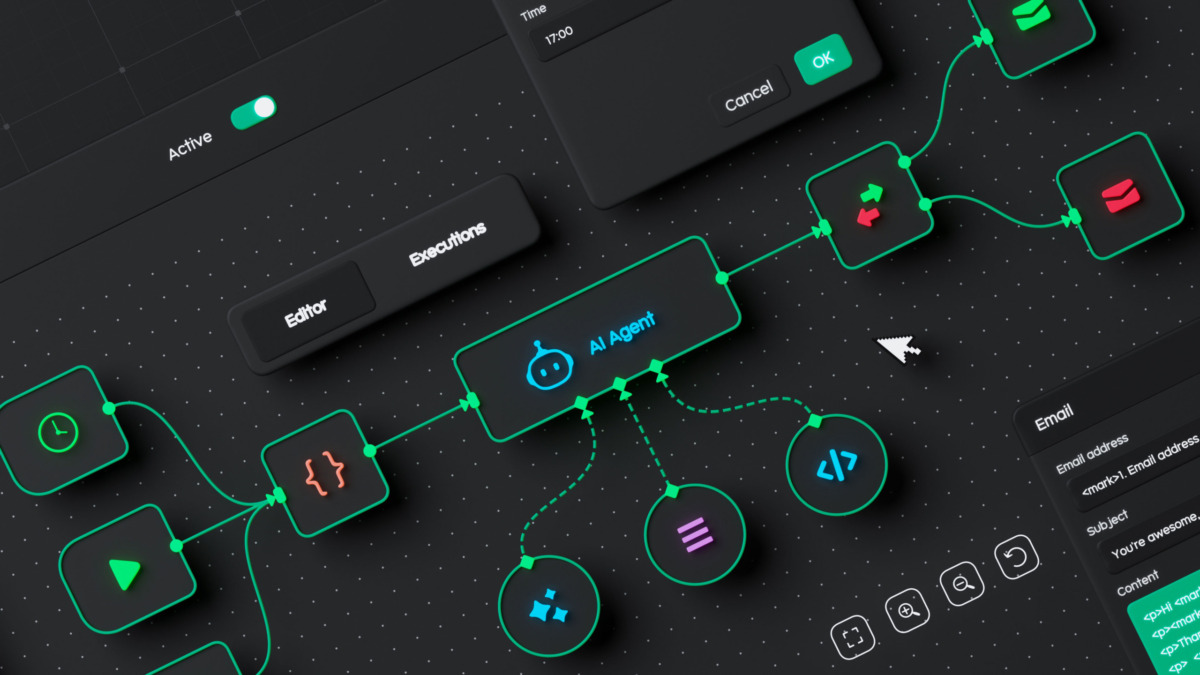Insights
The Future of Integration & AI: Choosing Tools Wisely in the Age of Agents
Ashleigh Green — 3 October, 2025

We’re at the start of a major evolution for enterprise integration. Integration has evolved dramatically over the past two decades. What once was primarily about batching, ETL, and point-to-point APIs has gradually morphed into real-time messaging, synchronisation, event-driven architectures, and unified data fabrics. Now, with the rise of AI agents and “conversational integration,” we’re entering a new phase: where the boundaries between integration, data, and user interaction blur.
To navigate this shift, organisations will need to get two things right:
- Choosing the right tool for the right use case in their existing stack
- Planning for a future where AI becomes a front door into systems
Leveraging the Right Tool in the Enterprise
When architects and integration leads talk about “the right tool,” they often mean which tool matches the requirements: cost, speed, complexity, security, maintainability, data modality, etc. In today’s environment, organisations typically have several tool classes at their disposal:
- Enterprise iPaaS / Middleware / ESB platforms (e.g. Azure Integration Services, MuleSoft, Dell Boomi, TIBCO, Oracle, etc.)
- Low-code / citizen integration platforms (e.g. Microsoft Power Platform, ServiceNow, Salesforce, Appian, etc.)
- Data fabric / unified analytics platforms (e.g. Microsoft Fabric, Snowflake, Informatica, Databricks Lakehouse, etc.)
- Emerging AI-centric connectors / agent integration layers (e.g. AI connectors, MCP, etc.)
These decisions are rarely black-and-white; they involve trade-offs across multiple dimensions. The table below outlines the most common considerations:
| Dimension | Why it matters | Typical tensions / tradeoffs |
| Scope & complexity | Some integrations are simple (e.g. synchronising contacts) while others are complex (multi-step business transactions) | A heavyweight ESB may be overkill for simple flows. Conversely, low-code tools may break down under complex transformations. |
| Speed to value / time to deploy | You may need to deliver ROI quickly | Low-code tools shine here, but may lack flexibility later |
| Cost of execution & maintainability | Licensing, runtime costs, support, and ongoing upgrades matter | Some platforms have high variable or consumption/execution costs; custom connectors are expensive to maintain |
| Nature of data / latency / volume | Streaming events, batch loads, large binary blobs, IoT / sensor data, each has different demands | A “one size fits all” tool is rare, you may need a hybrid architecture |
| Governance, security & compliance | Sensitive domains, auditability, data governance are non-negotiable | Legacy systems, fragmented security models, and shadow integration complicate this |
| Ecosystem & extensibility | The availability of adapters, community libraries, and vendor momentum | Choosing a niche platform can become a burden later |
An organisation might reasonably adopt MuleSoft or Azure Integration Services as a “core backbone” for heavy enterprise integration, while simultaneously employing Power Platform or ServiceNow for citizen-led, lower-risk scenarios. Meanwhile, a newer strategy is to adopt a data fabric or unified analytics layer like Microsoft Fabric, and embed integration capabilities as part of that stack, enabling operations and analytics to converge.
One of the key tensions in strategy is convergence vs specialisation. As analytics, integration, and AI platforms come under a unified umbrella (e.g. “fabric” offerings), the temptation is to collapse all layers into a single vendor. But optimal architectures will often remain hybrid, preserving specialised integration platforms when they excel, while gradually shifting “lower-value” flows into the unified layer.
Recommendation: Frame your tool decisions not as which platform wins but which tool is optimal for this use case, with clear criteria (cost, latency, security/data sensitivity, data shape, maintenance). Maintain a modular architecture so parts of your stack can evolve independently.
The AI Disruption: Agent Based Integration
The Evolution of Consumption: Integration to AI Agents
Historically, integration platforms focused on moving data between systems, real-time, near real-time, or batch-based. Their purpose was to ensure information flowed from systems of record to the applications that needed it.
The rise of enterprise analytics shifted this role. Data warehouses and BI platforms began collecting these flows, generating dashboards and reports that gave organisations historical insights into operations, customers, and risk. Over time, analytics evolved into predictive and prescriptive modelling, with architectures maturing from warehouses to data lakes and eventually lakehouses to handle scale, variety, and streaming data.
This created convergence: integration and data strategies started to overlap, with organisations seeking to reduce duplication of effort and cost by leveraging common tooling for both operational and analytical needs. Integration no longer just connected applications, it became the backbone that enabled unified data and decision-making across the enterprise.
Now, another shift is underway. AI agents are emerging as a new way that humans both consume information and directly drive change across systems. Instead of navigating screens or fixed dashboards, users will ask in natural language, receive insights, and in the same interaction trigger coordinated actions, with a single request updating multiple systems, enforcing workflows, and surfacing confirmations in real time.
What changes in this new mode?
- Operational data becomes dynamic. Instead of preselected KPIs, systems must fetch context on demand.
- Integration surfaces evolve into connectors. APIs must be exposed as callable tools with defined rules and mappings to business domains.
- Connector libraries emerge. Organisations will maintain central registries cataloguing ownership, domains, operations, and policies.
- Real-time expectations intensify. Latency and freshness are no longer negotiable.
- Context and orchestration become critical. AI agents must preserve state across sessions and interactions.
Meeting these expectations requires more than just APIs. It demands connectors that behave like tools agents can invoke safely, and standards like the Model Context Protocol (MCP) to enable consistent discovery, interpretation, and orchestration at scale.
Building AI-Ready Integration Architectures
To enable AI agents to both consume and act across enterprise systems, connectors need to evolve into tool-like constructs, callable functions that expose system capabilities in a safe.
One practical pattern for delivering this capability is emerging from the open-source ecosystem. Tools like n8n, LangGraph, and the Model Context Protocol (MCP) demonstrate how workflows, orchestration, and interoperability can come together to create an AI-ready integration stack:
- n8n as the workflow engine: business logic and system integrations are modelled as workflows. With MCP support, these workflows can be exposed as agent-callable tools (MCP servers) or themselves consume external MCP tools (MCP clients).
- LangGraph as the orchestration layer: providing the agent reasoning, context management, and conversation flow. LangGraph agents can discover and invoke MCP tools dynamically, deciding which connector to call and how to sequence actions.
- MCP as the universal protocol: the glue that standardises how agents and tools interoperate. MCP eliminates bespoke integrations by providing a single way to expose connectors and discover their capabilities.
Together, this creates an AI-ready integration architecture where:
- Enterprise systems are wrapped as MCP-compliant connectors (exposed via n8n).
- A central connector library governs those connectors, mapping domains, ownership, allowed operations, and policies.
- LangGraph agents orchestrate interactions across connectors, invoking the right workflows and maintaining context.
- MCP ensures interoperability, security, and discoverability across the stack.
The result is that a single natural-language request: “apply a 5% discount to Product X across APAC and update dependent systems” can be interpreted by LangGraph, routed through MCP, and executed via n8n workflows across multiple systems.
- The agent decides which systems must be touched (e.g. commerce, ERP, pricing engine).
- It discovers (via MCP) the relevant connectors for those systems.
- It orchestrates calls (with transactionality and error handling) to update data.
- It maintains audit logs, cross-checks data consistency, and surfaces confirmations back to the user.
Or imagine a hospital context: Tonight, the surgical ward has an unfilled shift. The manager asks: “Who can cover this shift under Fair Work rules, with the required surgical nursing credential, already onboarded at Hospital A, and within allowable working/rest limits?”
The AI agent reasons:
- It checks the roster / staff availability connector for nurses who have marked themselves available.
- It filters by credential service connector to confirm each candidate’s license/cert status.
- It queries HR / privileging connectors to confirm onboarding / cross-hospital privileges.
- It applies labour law / award rules connector to ensure no violation of hours/rest.
- It proposes best candidates, the manager approves one.
- The agent triggers workflow connectors to:
- Assign that nurse into the surgical ward roster.
- Notify the nurse, the unit manager, and relevant departments.
- Update HR/payroll systems across Hospital A and affiliated hospitals.
- Record an audit trail of all steps and decision rationale.
This pattern demonstrates how enterprises can move beyond dashboards and into dynamic, conversational workflows, where AI doesn’t just report on systems but safely drives change across them in real time.
Key Transitions & Adoption Considerations
The shift to agentic interfaces isn’t just a technology swap, it represents a change in how people interact with core systems and how those systems are governed. It touches architecture, compliance, user experience, and even trust in automation. Organisations should treat adoption as a journey, not a big-bang replacement.
Some practical considerations along the way:
- Start small, MVP first. Begin by wrapping a few critical systems with a conversational layer and progressively expand the connector library as confidence grows.
- Hybrid mode first. Users may still want dashboards and reports; the agent layer complements, rather than replaces, analytics and BI.
- Model versioning & interpretability. When an agent can modify systems, human oversight, audit trails, and rollback mechanisms become essential.
- Governance & security. Authenticate every agent request, validate permissions, and build safeguards against “jailbreak” behaviour or unsafe actions.
- Monitoring & feedback loops. Track agent decisions, errors, and drift, and continuously refine policies and models.
- Model/context synchronisation. Agents must remain aware of schema changes, evolving APIs, and updated business logic — connector libraries need ongoing maintenance.
Enterprises will also need strategies for legacy systems without APIs, which remain common. Wrapping them with adapters, RPA bots, or intermediate APIs can provide bridge capabilities.
The key is to approach adoption as an incremental transformation. Layer conversational access on top of existing systems, expand coverage through governed connector libraries, and embed security and oversight at every step. Done well, this provides AI agents enhance decision-making and operational agility whilst maintaining trust, compliance, and stability.
Putting It All Together — A Strategy Roadmap
The integration and AI landscape is evolving at a rapid pace, new tools, frameworks, and patterns emerge every other week. What looks like best practice today may be replaced tomorrow. Because of this, organisations should avoid locking themselves into rigid architectures or vendor ecosystems. Instead, the goal is to design a modular, adaptable approach.
That means putting the emphasis on categorising systems, data domains, and connectivity rules:
- Which systems are system-of-record vs system-of-engagement
- What data domains they own and how they can be accessed
- What security, compliance, and governance rules must be applied
Once those foundations are clear, the right tools can be applied, but with the expectation that they may change. By decoupling design principles from the specific tools, organisations can swap out platforms as better options or new patterns emerge.
Progress should also be incremental and value-driven. Delivering small, deliberate steps with clear quick wins maintains momentum and builds trust, while laying the groundwork for larger transformations.
The following roadmap outlines a potential approach to this journey in practice.
Foundational Steps
- Inventory & classification
- Catalog systems and integration flows
- Classify by criticality, complexity, latency, data shape
- Define integration/design principles
- For each class, pick appropriate tool types (iPaaS, low-code, or fabric)
- Define clear APIs, event contracts, interfaces
- Build a connector layer / abstraction
- For key systems, build wrappers or adapters (ideally conforming to future agent protocols)
- Ensure metadata, error semantics, audits
Control Plane & Pilots
- Select an orchestration / control plane
- Use or evolve a central orchestrator (or LLM-driven orchestrator)
- Decouple orchestration logic from connector logic
- Pilot conversational or agent interfaces
- Wrap a small domain (e.g. “sales insights + simple actions”)
- Use an agent to call your connectors & return results
Governance & Iteration
- Govern, monitor, iterate
- Log all agent actions, handle errors gracefully
- Introduce model constraints, approval steps
- Evolve connector semantics & agent training
Scale & Convergence
- Evolve to scale
- Expand connector coverage
- Embed agent access across domains
- Consider standards (e.g. MCP) as connector library grows
- Explore convergence with data fabric / analytics
- For data-intensive flows, leverage your analytics platform (e.g. Fabric) as the backbone
- Move noncritical integration flows into the fabric where appropriate
Ready to prepare your enterprise for the future of integration and AI?
Discover how our integration services can help you build scalable, AI-ready architectures.
References
- Forbes – Why Agent Orchestration Is The New Enterprise Integration Backbone For The AI Era
A strategic perspective on how orchestration of AI agents is becoming the de facto integration backbone in modern enterprises. - exposé Data Blog – Building Agentic Workflows with n8n and LLMs
A practitioner’s view on how n8n and large language models can be combined to create workflows that move beyond simple pipelines into agent-driven automation. - RedHat – Optimizing application architectures for AI: From monoliths to intelligent agents – Part 1
An enterprise architecture perspective on how systems are evolving toward modular, agent-ready designs. - Late Note Blog – LangGraph MCP Integration
A technical exploration of how LangGraph and the Model Context Protocol (MCP) combine to allow dynamic discovery and orchestration of AI tools. - Anthropic – Introducing the Model Context Protocol (MCP)
The original announcement and explanation of MCP, outlining its role as a universal standard for connecting AI agents with external tools and systems.


